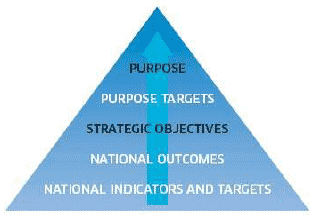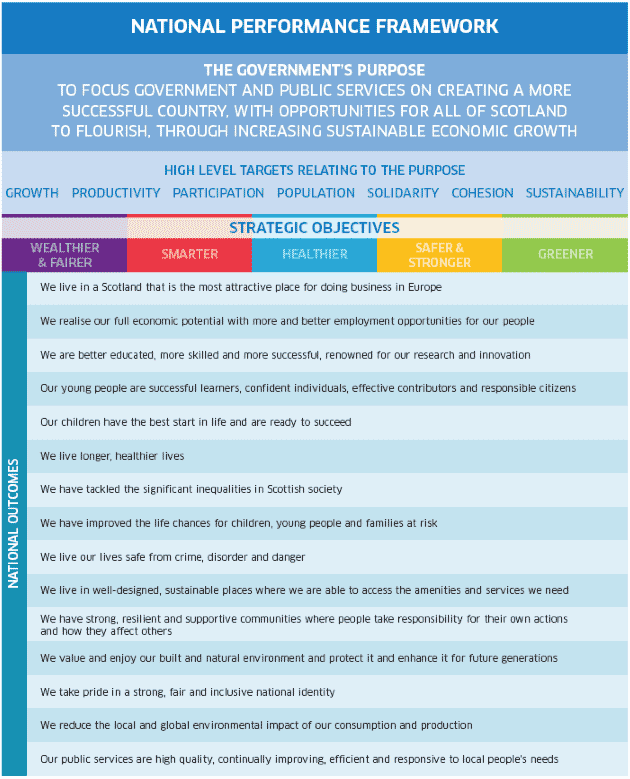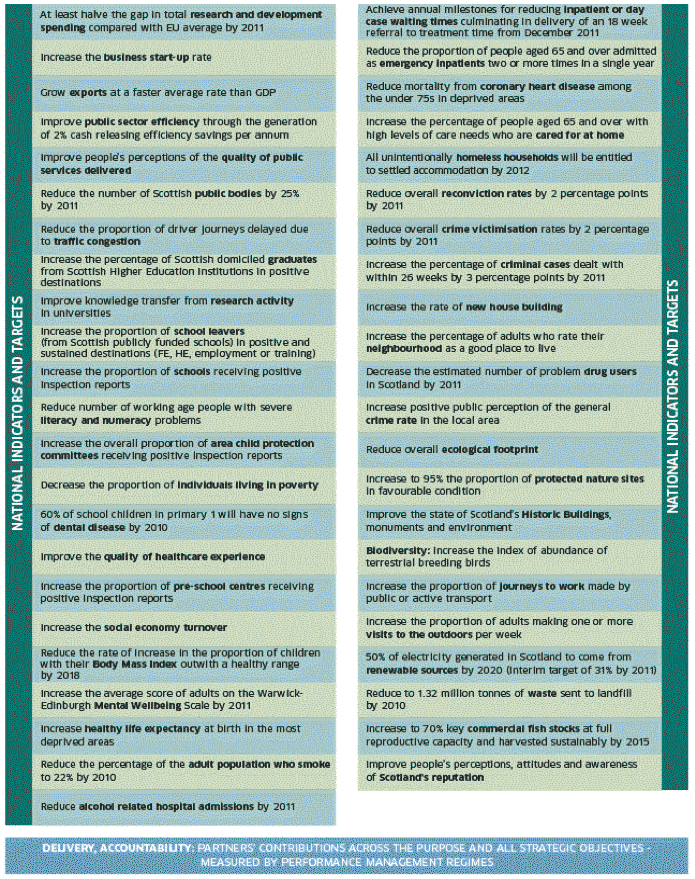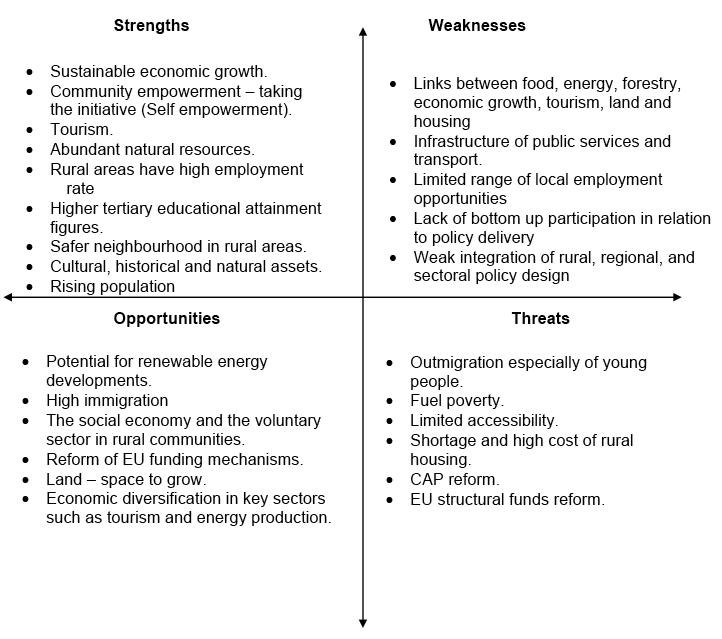Developing Performance Indicators for Rural Scotland: A Scoping Study
Scoping project assessing suitability of existing performance indicators to rural Scotland.
1.0 Objectives and context for the scoping study
1.1 ECOTEC appointment
ECOTEC Research and Consulting Limited were appointed by the Scottish Government in March 2008 to undertake a scoping study exploring the potential for the development of performance indicators for rural Scotland.
1.2 The purpose, scope and expectations of the study
The purpose of this scoping study is to investigate and scope out issues associated with developing performance indicators for rural Scotland.
The research objectives for the project are as follows:
- To review the indicators in the National Performance Framework and assess their relevance to rural Scotland.
- To review existing indicators in other strategies and assess their relevance to rural Scotland as well the availability of data sources for the indicators identified.
- To review approaches used to monitor progress for rural areas in other countries and to extract lessons for transfer where appropriate to the Scottish context.
- To summarise the issues associated with developing a set of rural performance indicators.
The scoping study explores the extent to which the National Performance Framework in Scotland is and can be responsive to the particular circumstances of rural Scotland. The National Performance Framework was launched by the Scottish Government in November 2007 and is an outcome based approach to performance management. It consists of 15 outcomes and 45 indicators which are designed to track progress.
The study also looks at a range of other indicator sets relevant to rural Scotland, for example those set in relation to the Scotland Rural Development Programme ( SRDP) 2007-2013. In addition, the study seeks to understand lessons that may be learned from our near neighbours in Europe in terms of how they monitor success in their rural areas.
Finally, the study goes on to discuss and summarise the key issues in developing a set of indicators.
1.3 Research methodology
In order to meet the requirements of the brief, the research team undertook desk based reviews of data and research relevant to Scotland to inform the study. A list of references is included at Annex One for information.
In addition, the research team were assisted with access to source material by officers represented on the project Steering Group and in particular those from the Rural and Environment Research and Analysis Directorate of the Scottish Government.
In relation to the case study countries, an initial framework for selecting countries was devised and agreed with the study Steering Group. The selected countries were then analysed through a combination of website reviews and discussions with associates located in case study counties, enabling the team to source relevant data and material. In this respect, the Organisation for Economic Cooperation and Development ( OECD) rural team were helpful, enabling access to their rural policy review data.
1.4 Putting the scoping study into context
1.4.1 The Scottish Government agenda
The SNP Scottish Government elected in Scotland in May 2007 announced their intention to move the whole operation of government to an outcomes-focused approach towards assessing expenditure and performance. This was to provide a focus on the long term challenges facing Scotland and to ensure the alignment of the whole of the public sector, working towards one overarching Purpose:
"… To focus Government and public services on creating a more successful country, with opportunities for all of Scotland to flourish, through increasing sustainable economic growth…" 1
Figure 1.2: The National Performance Framework

Supporting this Purpose are a set of Purpose Targets as follows:
- Economic Growth ( GDP)
- to raise the GDP growth rate to the UK level by 2011.
- to match the GDP growth rate of the small independent EU countries 2 by 2017. - Productivity
- To rank in the top quartile for productivity against our key trading partners in the OECD by 2017. - Participation
- To maintain our position on labour market participation as the top performing country in the UK.
- To close the gap with the top five OECD economies by 2017. - Population
- To match average European ( EU15) population growth over the period from 2007 t0 2017.
- Supported by increased healthy life expectancy in Scotland over the period 2007 to 2017. - Solidarity
- To increase overall income and the proportion of income earned by the three lowest income deciles as a group by 2017. - Cohesion
- To narrow the gap in participation between Scotland's best and worst performing regions by 2017. - Sustainability
- To reduce the emissions over the period to 2011.
- To reduce emissions by 80 per cent by 2050.
The Framework then proposes a set of five Strategic Objectives to support the delivery of the Purpose. For Scotland to become:
- Safer and stronger
- Wealthier and fairer
- Smarter
- Healthier
- Greener
In order to monitor progress against the purpose and the five strategic objectives, the new performance measurement framework establishes a related set of 15 National Outcomes, in turn supported by 45 National Indicators and targets, illustrated below and overleaf in Figures 1.3 and 1.4.
Figure 1.3: Strategic objectives, national outcomes

Figure 1.4: National indicators and targets

Source: The Scottish Government
1.4.2 Implementation at the local level
The ambition of the Scottish Government in establishing their Purpose and National Performance Framework is also to orchestrate a transition to an outcomes-based approach with delivery partners, thereby leaving government to focus upon strategic leadership, direction and priorities. Towards this end a process known as Single Outcome Agreements ( SOA) has been put in place between national and local government (via Community Planning Partnerships) with SOAs articulating how they contribute to the National Performance Framework. A menu of locally relevant indicators has also been developed from which Community Planning Partnerships may pick and choose to reflect their particular circumstances - one key aspect of which may well be the rurality of the area involved. This menu currently involves some 52 local indicators 3 .
Again, with reference to the work undertaken in this report, the SOA approach to indicator development and reporting should be aligned with rurally specific indicators - and wherever possible, SOA indicators should be developed so that they enable 'rural-tagging' i.e. the analysis of data according to the urban rural definition adopted by Scotland.
1.5 Understanding rural Scotland
As noted by Richard Lochhead in his speech at the Rural Gathering event in September 2009, the Scottish Government wish to see a "rural Scotland which presents to the world a dynamic, active, modern society, able and willing to use all that the 21st century can offer while capitalising on its heritage."
Measuring progress towards this vision, along with tracking the essential characteristics that make up rural Scotland, is a challenging task: the very characteristics of rural areas - for example, low population density and remoteness - mean that what constitutes success in rural areas (and how it is measured) may be different from the rest of Scotland.
In 2008, the OECD produced a Rural Policy Review of Scotland 4 . This publication highlights a number of key points regarding the profile of rural Scotland:
- Scotland's 'predominantly rural' regions using the OECD classification (described in Chapter 2) comprise 75% of the land area, 17% of the population and 13% of its Gross Domestic Product ( GDP).
- Scotland's rural areas as a whole display good socio economic indicators, compared to urban and intermediate areas, with higher income levels and better health standards, levels of tertiary education, employment rates, liveability and neighbourhood safety. In addition, unemployment is lower than in urban areas and home ownership higher.
- Most rural regions in Scotland had rates of growth above the OECD average.
- Rural areas in Scotland have been net receivers of population since the late 1980s with the share of the population living in rural areas increasing.
- However, rural areas across Scotland are not homogenous and considerable differences are seen between accessible rural regions and the very remote highlands and islands in particular. Here, several indicators point to underperformance closely correlated to inadequate infrastructure and high transportation costs, for example income levels, employment, skills and health.
- Finally, Scotland's employment profile is undergoing change with service industries outpacing the primary sector and new potential for growth demonstrated in sectors linked closely to the natural asset base, for example tourism and energy.
1.5.1 Strengths, weaknesses, opportunities and threats
Figure 1.5 presents a summary SWOT analysis drawing on a combination of reviews relating to rural Scotland: particularly Rural Scotland: Better Still, Naturally 5 , the Scotland Rural Development Programme 6 and the OECD Rural Policy Review. This synthesis identifies some common themes in these various approaches and summarises them as a reference point for this study. The strengths and weaknesses refer to the current situation; threats and opportunities refer to likely changes in the environment in the future. In some case it is not certain whether the effect will be negative or positive or it is possible that a change, for instance funding arrangements, offers both threats and opportunities, perhaps to different sectors. A SWOT analysis can provide a framework for thinking about policies, but in the current instance we are primarily interested in identifying themes.
Figure 1.5: A SWOT Analysis for rural Scotland

1.5.2 OECD priorities for rural Scotland
Building from their analysis, the OECD review highlighted the following as being key priorities for the future growth and prosperity of rural Scotland:
- To address the shortage of affordable housing.
- To improve service delivery and related investment strategies, particularly linked to education, healthcare, ageing and transport infrastructure.
- To continue to diversify the economic base beyond agriculture, with particular attention paid to tourism markets, forestry and energy.
- In support of the above, to provide improved supporting services and infrastructure to foster SME growth.
- To recognise and understand further the opportunities arising through urban rural interdependency and linkages and to develop appropriate policy responses.
- The OECD also proposed that, in order to meet the challenges of the future, Scotland needs "…a distinct, integrated rural development policy…" and "…better targeting rural policy to different rural areas…" This view supports the notion of developing and using specific rural indicators to target intervention and measure success and impact.
1.5.3 In conclusion - key themes for rural Scotland
Following the SWOT analysis, the study team were able to develop a list of the themes that were considered to be critical to inform the development of performance indicators in rural Scotland:
- Developing agriculture and forestry (as key 'triggers' of other rural and urban industries (for example, manufacturing and food processing).
- Diversifying the rural economy - including 'green jobs' (renewable energy etc), diversification of agricultural activities and tourism.
- Creating balanced rural communities (demography) - with a mix of ages and skill levels.
- Improving supply of and access to affordable housing or increasing the availability of housing that is affordable.
- Improving access to services and mobility (travel times, public transport, internet/broadband availability).
- Enhancing social capital 7 , i.e. strong social networks as an indicator of the resilience of rural communities.
- Promoting community empowerment, to stimulate and harness the energy of local people to come up with creative solutions to local challenges.
- Improving living standards and income levels, including the price of housing.
- Enhancing the quantity, quality and enjoyment of the physical environment/landscapes/cultural and natural heritage.
- Increasing the degree of innovation and collaboration/partnerships in business.
1.6 Report structure
The remainder of the report is structured as follows:
- Chapter 2 : presents background information and discusses the need for key performance indicators for rural Scotland and what makes good indicator
- Chapter 3 : sets out an analysis of the relevance of the indicators in the Scottish Government's National Performance Framework to rural Scotland.
- Chapter 4 : explores existing indicator sets and describes their data sources.
- Chapter 5 : provides a summary of our analysis of case study countries.
- Chapter 6 : summarises the key issues in developing indicators.
- Annex One : provides a list of reference material for the study.
- Annex Two : details the types of indicators used in the European Commission Common Monitoring and Evaluation Framework employed for measuring the impact of the Scotland Rural Development Programme 2007-2013.
- Annex Three : lists the strategy documents consulted to identify additional indicators which could supplement the national performance indicators.
There is a problem
Thanks for your feedback